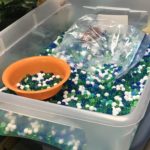Your child is crying. Hitting their head. You know something is bothering them, but they can’t tell you what it is. As a parent or provider, it can be SO frustrating not to know what to do when a child needs our help. And imagine how they must feel!
Sometimes our students just need a little extra support. When you are seeing excessive behaviors in the class or at home, we need to remember that it’s rarely personal. These behaviors are communicating unmet needs to us. The first step is always to try to teach communication strategies. It opens worlds when children are able to communicate their needs. However, if the communication piece is not quite there yet, we can help mitigate some of the uncomfortable situations that our students may be feeling.
Children and Adults with Autism, Sensory Processing Disorder, and even ADHD/ADD have consistently reported under or over-sensitivities in many of the basic senses (sight/smell/touch/taste/proprioception). For example, a student with an UNDER-sensitivity to touch may SEEK out texture by touching objects, hitting his hands on things, or rubbing clothes, while a student with an OVER-sensitivity to touch may refuse to wear certain clothes or clothes with tags, refuse touch from others including hugs, or refuse some textured foods.
The behavior the child is expressing may clue you in on what sensory support they need. Need some tips for integrating quick and inexpensive sensory items into your home? Here is a quick look into some of my most frequently used.

Got a child who is constantly chewing on their clothes, vocal stimming, or biting themselves or others? Try Chewlery or “Chewy’s”. They keep their mouths busy, give soothing pressure for their teeth and jaw, and can help keep mouths quiet during work time with minimal disruptions.

These vests come in a variety of styles and sizes. They even can come weighted and you can adjust the pressure for students who need some sensory pressure. I recommend using these for only 30 or so minutes at a time as I have seen their effectiveness decrease if the student gets used to it. The vest gives calming pressure to the student (like a big body hug) and can calm proprioceptive sensory-seeking students. We use ours during large group times like Circle and Art.
Another option for a student who is tactile driven but doesn’t like the deep pressure like with vests is Body Sox! See Below!

When we first started using these we had to tie Physical Therapy bands around the front legs of student chairs. Now they make ones especially to fit school chairs! Students can bounce their feet or stretch with the bands for pressure on their feet. Works well for kiddos that can’t sit still for long or have feet that are constantly tapping or bouncing. Caution, they can be a little noisy!
Another sensory fave for chairs and sitting time are these fidget discs!

They allow for a wobble when sat on or the kiddo can use the bumpy side on their feet when sitting!
In our classroom, we scheduled 2-3 special sensory ‘activities’ for our afternoon centers per week. One of our favorites was these sensory beads (similar to Orbeez) I found these a few years ago at the CA State Fair for 3$ a bag and was hooked! I’m sure you have seen them around, but you can buy the off-brand for super cheap on Amazon.
We place them in a big tub and take some out in bowls as needed for students who can’t quite reach the tub or need their own sensory space. These can leave a little film on your hands but are non-toxic and easy to clean up. They even can be “re-hydrated” When they dry out! Just add a little more water and let soak! We store ours in a plastic ziplock bag.
Some other simple activities for our sensory exploration time include:
- Sensory Snow (Conditioner + Baking Soda = Messy but awesome fake snow!)
- Rice or Bean Bins
- Sand Bins
- Kinetic Sand
- Play-Doh
- Sensory Boards
- Gak/Slime (Make it yourself with glue/contact solution or store-bought)
There are so many more options for fun sensory diets in the classroom and at home. I am a huge proponent of turning sensory items into daily activities, but setting aside some time for strict sensory exploration or including it in a center can be helpful and give the sensory-driven student something to look forward to.
What other sensory options have you explored for your child? What was their favorite?
